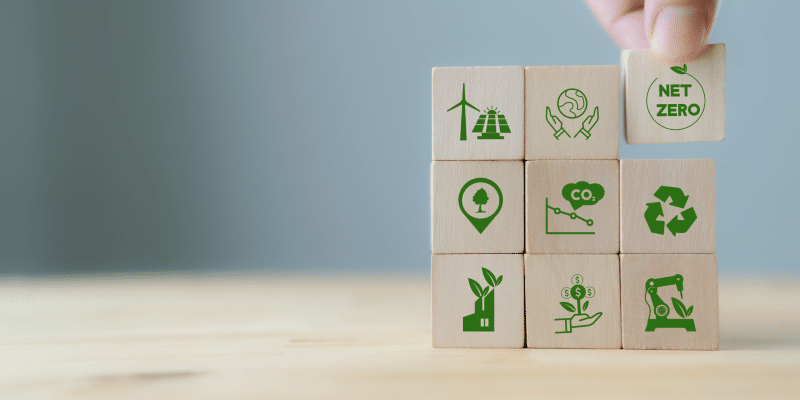This piece was co-authored by Christina Nuñez Ross, a former Director of Communications here at the Christensen Institute
Depending on one’s perspective, the 2021 United Nations Climate Change Conference (COP26) was either an encouraging step towards meaningful climate action, or more of the same empty promises that won’t get fulfilled.
Ever the optimist, Bill Gates belongs to the first camp. After spending three days at the climate summit in Glasgow, Scotland, he wrote that, “Some people look at the problems that still need to be solved and see the glass as half-empty. I don’t share that view…the glass is being filled up faster than ever…If we keep this up—if the world puts even more effort into innovations that reduce the cost of getting to zero and help the poorest people adapt to climate change—then we’ll be able to look back on this summit as an important milestone in avoiding a climate disaster.” He added in Financial Times, “It’s not enough to invent zero-carbon alternatives—we need to make sure they’re affordable and accessible enough for people all over the world to use them.”
Gates has made an important distinction by advocating for clean-technology innovations that reach the world’s poor. While the years since the 2015 Paris COP have seen a significant increase in funding and R&D for clean technologies like sustainable aeroplane fuel, green steel and extra-powerful batteries, the world can’t get to zero emissions until such innovations become ubiquitous. In order to reach the 689 million people living in extreme poverty and the millions of others who live just above the extreme poverty line, innovations like these will need to become simpler, more affordable, and more accessible.
For many innovators who have experience targeting high-end markets, this will require a fundamentally different way of thinking. Reaching people who traditionally haven’t been able to consume products and services—whom we call nonconsumers—is as much about reducing barriers to consumption through innovative business models as it is about technology.
Reducing barriers to reach nonconsumers
Previous research has revealed a framework for helping innovators understand the four major barriers to consumption: money, access, time, and skill. In the Christensen Institute’s research studying 100 diverse organizations that targeted nonconsumers, all needed to overcome at least one of these four barriers to consumption, while 95% needed to overcome multiple barriers at once.
The process for discovering and reducing customers’ barriers to consumption requires a keen understanding of customers’ struggles and, often, a degree of trial and error. To illustrate, consider how MicroEnsure, an organization that provides insurance for people in Africa, Asia, and North and South America discovered and then overcame all four barriers in its efforts to create a new market during the early 2000s.
For many living in growth economies, falling into poverty is often one unforeseen life event away. However, despite this reality, access to insurance products that can help mitigate financial setbacks is very limited. Richard Leftley, MicroEnsure’s founder, made it his life mission to solve this problem. Two barriers causing nonconsumption of insurance were obvious to Leftley: it cost too much and was difficult to access in too many places. Leftley overcame these barriers by partnering with mobile telecommunication companies, which had already penetrated many emerging markets.
Rather than requiring customers to purchase insurance through a conventional network of sales agents that would take years to assemble, Leftley and his mobile network partners developed a model in which customers could simply purchase it along with their cellular subscription plans. Piggybacking on mobile telecommunication companies’ well-established sales networks allowed MicroEnsure to reach customers in convenient locations close to their homes, thus efficiently overcoming the barrier of access. Customers gained basic insurance for free when purchasing mobile credits, and could add family members or increase their coverage for a small fee. MicroEnsure received a commission of these sales, operating as a middleman between mainstream insurers, who gained new customers, and mobile phone companies, who gained a new revenue stream.
This innovative business model allowed all parties involved to benefit. However, access and money-related barriers were not the only obstacles causing the nonconsumption of insurance; time and skill-related barriers were at play, too. Many of the customers MicroEnsure hoped to serve didn’t have the literacy skills to read lengthy insurance contracts, and often lacked photo IDs and other documentation. This made registering for insurance complex and time-consuming.
Leftley and his team boiled the process down to three questions that took less than a minute to answer, but even so, they found that many customers still had difficulty filling out the questionnaire on their own. MicroEnsure eventually got rid of the questions altogether, instead relying on a single piece of information: the customer’s phone number. The benefits of simplifying the sign-up process far outweighed the risk for MicroEnsure, which registered 1 million new customers on the first day it offered a new life insurance product in India. Tens of millions more have joined since, more than 85% of whom have never used an insurance product before MicroEnsure.
The inconvenient truth about reaching net-zero
Developing new clean-tech innovations, figuring out how to scale them, and determining how to reach the world’s nonconsumers is a tall order, and advice like “make your innovation affordable” is more easily said than done. Indeed, Gates points out in his recent piece for Financial Times that innovators seeking to launch new, clean tech face unique challenges. Climate-smart technologies, he writes, need to be proven at scale, which is incredibly expensive. Green technologies themselves may also initially be more expensive than what they’re replacing, making them difficult to finance.
Still, I remain, like Gates, optimistic. When the world sets its mind on solving intractable problems like poverty and climate change, anything is possible. The key is understanding how to frame the problem.



